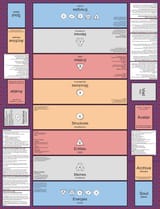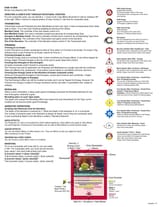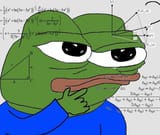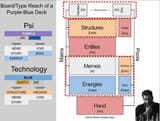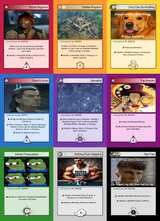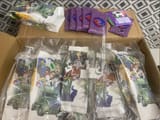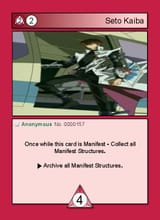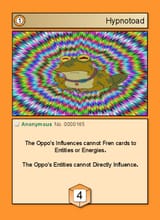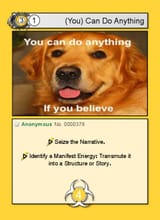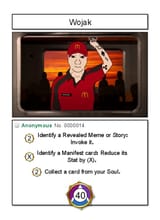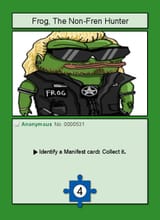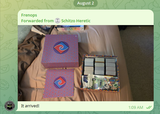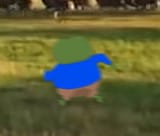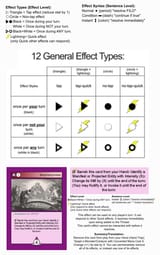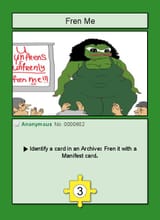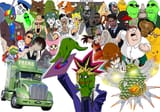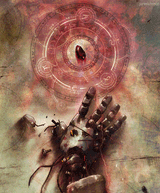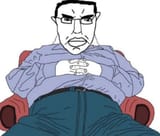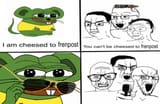Frenopolis General
Frenopolis is an open source gamified microcosm where players seek to outmaneuver each other to control the elements and their manifestations which comprise the world.
It is easiest to learn with any YGO/MTG experience.
You can request a free physical 2-player/90 card playtesting starter set by following the instructions in description of this video:
(no identifying or payment information required)
https://youtu.be/oPoBUoagO_k
Tabletop Simulator demo implementation:
(let me know if you'd like to set up a game)
https://steamcommunity.com/sharedfiles/filedetails/?id=3532880446
Physical Game Demo:
https://youtu.be/KIGdAsFzgHI
Anonymous
8/8/2025, 12:07:21 AM
No.96274025
[Report]
>>96274032
>>96274007 (OP)
picrel is a starter playmat which has all the zones and basic rules/definition/mechanic reminders.
It is 30*22inches, 2 inches longer than MTG starter playmats which serve the same function.
Anonymous
8/8/2025, 12:08:26 AM
No.96274032
[Report]
>>96274025
Here is a quick reference sheet that covers the more advanced interactions. It is 8.5*11inches (single side).
Between the starter playmat, and this quick reference page, you can play at an advanced level.
How to understand Frenopolis in the context of Chess:
A chess board is composed of 2 colors (black and white) and 6 unique pieces (king, queen, rook, bishop, knight, and pawn).
The identity of each piece is characterized by its unique movement on the board. For example:
Pawn: Moves 1 square forward
Knight: Moves 2 then 1 perpendicular
Bishop: Moves diagonally on its color.
Rook: Moves horizontally.
King: Moves in 1 in any direction.
Queen: Moves diagonally or horizontally.
If you were to assign each of these movements an identifier (abstract them), you would end up with something like this:
Pawn: Move 1 square forward = P
Knight: Move 2 then 1 perpendicular = N
Bishop: Move diagonally on its color. = B
Rook: Move horizontally. = R
King: Move 1 in any direction. = K
Queen: Move diagonally or horizontally. = Q
In this way, you could define the Queen's movement (moves diagonally or horizontally) as:
>Queen = Moves horizontally (Rook “R”) + Moves diagonally on its color (Bishop “B”)
>Queen = Rook + Bishop
Queen = R + B
If you understand how a Chess piece's movement can be abstracted from the piece, you can understand how Frenopolis is constructed.
>>96274052
Frenopolis is like Chess, except the board has 4 colors instead of 2, and only 10 squares instead of 64. All of the movements between those 4 squares are abstracted (ex Pawn: Moves 1 square forward = P) and distributed onto cards. There are tables that serialize every single movement between every color. These movements are mixed and matched to create Frenopolis cards.
A chess example of this:
Pawn: Moves 1 square forward = P
Knight: Moves 2 then 1 perpendicular = N
Pawn-Knight = P + N
This meta piece “Pawn-Knight” is able to do both the actions of a Pawn and a Knight, in a single piece. Sort of like how a Queen is a combination of a Rook and Bishop. The movements are abstracted and combined to form a new piece.
Frenopolis cards are analogous to meta chess pieces on 4-color 10-square board. Once you learn the basic movements, it is easy to understand any card.
Anonymous
8/8/2025, 12:23:26 AM
No.96274122
[Report]
>>96294724
>>96274052
>>96274076
The 4 colors that make up the Frenopolis board are called "elements":
Fire, Air, Water, and Earth
All the board zones and card types are assigned 1 of these 4 elements.
Each card color (Red, Orange, Yellow, Blue, Purple, Violet) are defined as 2-combinations of the elements which comprise the board and the card types.
Defining all effects in terms of these elemental relationships allows a strict correspondence between the game board and color pie. The effect scope of each color is strictly defined and predictable.
You don't need to know this to play – you can just follow the written card text, but knowledge of the underlying design allows for more advantageous play.
Anonymous
8/8/2025, 1:13:58 AM
No.96274433
[Report]
For example:
A Purple (Psi) and Blue (Technology) deck will have a strictly predefined interaction scope:
Purple [Psi] (Air/Water) have effects which involve:
Memes (Air), Stories (Air), and Energies (Water)
in/to/from the:
Void (Air), Soul (Water), and Matrix (field)
Blue [Technology] (Air/Earth) have effects which involve:
Memes (Air), Stories (Air), and Structures (Earth)
in/to/from the:
Void (Air), Archive (Earth), and Matrix (field)
Purple (Air/Water) and Blue (Air/Earth) have an elemental conjunction (overlap) in the Air element. This means that a Purple/Blue deck will have effects which involve:
Memes (Air), Stories (Air), Energies (Water) and Structures (Earth)
in/to/from the:
Void (Air), Soul (Water), Archive (Earth), and Matrix (field)
Anonymous
8/8/2025, 1:51:35 AM
No.96274609
[Report]
Some card samples.
Anonymous
8/8/2025, 6:22:44 AM
No.96275930
[Report]
>>96279927
picrel is a box of starter/playtesting sets.
They each contain 6 packs of 15 cards each.
Each pack contains:
11 of a single color (all 6 packs are the same mono color)
2 Frens (green)
1 Story (grey)
0-1 Colorless (black)
0-1 Avatars (white)
Each of these kits contain 90 cards, and exactly 1/2 of a full color. There are 6 basic colors, so 12 sets total. There is no randomization or repeats. If you were to get all 12 kits, you'd have a complete 1080 card set.
To play with these starter sets, all you need to do is remove the white cards (avatars), then shuffle the cards together, and split the pile in half.
Then you need to select 1 of the removed avatars for each of the 2 players.
After that you can begin playing.
Anonymous
8/8/2025, 6:27:41 AM
No.96275950
[Report]
There are 7 card types in Frenopolis. A card's type is indicated by the symbol on the bottom of the card which contains its stat. There are no subtypes.
They are:
1.) Entity (like creatures or monsters)
2.) Structure (like artifact-sorcery-walls or perma defense mode monsters)
3.) Meme (like instant sorceries or trap cards)
4.) Story (like a field spell)
Entities, Structures, Memes, and Stories only differ in their Type designation and how they conduct combat.
For example:
Structures do not conduct combat at all.
Stories +1 cards.
Memes -1 cards.
Entities subtract their stat from their target.
5.) Energy (like mana)
6.) Avatar (like a commander)
7.) Fren (like a xyz monster)
These comparisons are rough and simplified, and I will explain them each in more detail below.
Anonymous
8/8/2025, 6:33:05 AM
No.96275975
[Report]
>>96276108
>>96275958
Entities:
Entities are the primary damage dealer in the game. In MTG terms, they have Haste, Trample, and Vigilance by default.
Entities are vulnerable to other Entities because the other Entity only need to have 1 stat higher to remove it through combat.
Entity's effects are usually tap effects. Tap in Frenopolis means "reduce stat by 1" (it also has a 90 degree rotation, but it can be repeated 4 times before returning to its original position because the cards have 4 stat). This means that to use an Entity effect, you have to make it weaker, and it makes it especially vulnerable to other Entities which all have a base stat of 4. In this way Entity effects are expensive and high risk.
The combat operation for Entity vs Entity is:
Reduce each Entity's Will from the other until the end of the combat phase, and subtract any difference from the player who controls the lower stat card.
Entities also have a more difficult time against Structures. The combat equation for Entity (Will) vs Structure (Equilibrium) is:
(Will - Equilibrium) +1
Because all the basic card types have 4 stat, this means it would take an Entity (with 4 stat) 3 turns to get through a single Structure (with 4 stat).
Example:
On the first attack the Entity would do 1 damage: (4 Will - 4 Equilibrium) + 1 = 1 damage, resulting in a 3 stat Structure.
On the second attack the Entity would do 2 damage (4 Will - 3 Equilibrium) + 1 = 2 damage, resulting in a 1 stat Structure.
On the third attack the Entity would do 4 damage (4 Will - 1 Equilibrium) + 1 = 4 damage,
resulting in a -3 stat Structure. Cards are removed when they reach 0 stat.
Entities cannot attack other player's Entities if they control any Structures. The Structures must be removed first.
Entities cannot conduct combat against Memes.
You choose the targets for all attacks, like yugioh.
Anonymous
8/8/2025, 6:36:33 AM
No.96275991
[Report]
>>96276108
>>96275958
Structures:
Structures are your primary defense and cheap/reliable effect output.
Structures cannot conduct combat, but they prevent the other player from attacking your Entities or your Avatar directly. They are like a defensive wall.
Structure's effects are usually once-per-your-turn (no tap), meaning they can be used for free during your turn. This makes them very reliable low risk effect output.
Anonymous
8/8/2025, 6:38:19 AM
No.96276003
[Report]
>>96276108
>>96275958
Memes:
Memes are your primary ranged damage and fast/expensive effect output. Memes can be played on any player's turn (the rarespawn symbol on the Energy cost), like a MTG instant.
Meme effects are generally once per EITHER player's turn, and Quick. This effectively doubles their effect output relative to other cards. Quick means that their effects can only be responded to by other Quick effects. This is like spell speed 3 in yugioh.
Memes cannot be attacked, except by other Memes.
Memes do not protect your Avatar from being attacked.
They are like a spell/trap/sorcery that has a specialized mode of combat.
Meme Combat:
Memes have 2 options for combat. They can:
1.) -1 (tap) any card on the field.
2.) Reduce the Meme's stat (Virulence) by X, then reduce the stat of any card on the field by X.
These options are mutually exclusive - you can only choose one.
Memes are especially useful for strategically sniping cards out of reach, such as reducing an expensive Entity's stat (Will) by 1, making it vulnerable to even the cheapest Entity. Because a card's combat, health, and effect output power are combined into 1 stat, reducing a card's stat reduces all of those things.
When you build powerful Memes, you can remove complete cards in one hit.
Anonymous
8/8/2025, 6:41:42 AM
No.96276022
[Report]
>>96276108
>>96275958
Energies:
Energies function similarly to MTG mana, but there are no dedicated Energy cards. Energies are any card you play upside down from your hand into the Energy zone.
Energies do not conduct combat.
Energies can be used to pay for cards and energize your Avatar, giving access to powerful Avatar effects.
Cards give Energy color corresponding to their color. So a Blue card gives Blue Energy. A Green card (a fren) gives Green energy.
Energy removal is one of the most expensive and restricted effects in the game.
Transmutation of Energies is one of the most powerful effects in the game, because it allows you to play (invert/turn right side up) an Energy from your Energy zone. You basically get a free card at the cost of an Energy. See more on Transmutation.
Anonymous
8/8/2025, 6:44:06 AM
No.96276036
[Report]
>>96276108
>>96275958
Avatars:
Avatars are similar to MTG commanders, but they are not cast into the battlefield, and they set your Time (life) for the game. Avatars can even grant unique win conditions.
Avatars have effects which can be used at any time as long it has the requisite Energy.
You can add Energy (Energize) your Avatar once per turn by tapping X Energies of the same color which are indicated on the Avatar's Time symbol.
Most Avatars can be Energized by 3 of 6 Energies, so not all Avatars work with all decks.
Picrel Avatar, "Wojak" can be Energized by the Purple, Violet, and Blue colors.
There are 4 Avatars which can be Energized with any Color.
Avatars generally have some sort of generic card draw effect, and then other effects which correspond to the elements which comprise their compatible Colors.
You can attach(Fren) cards to your Avatar, and Avatars can be nullified (temporarily remove their effects).
Identical decks with different Avatars may have vastly different approaches to gameplay.
When your Avatar's Time reaches 0, you loose.
Anonymous
8/8/2025, 6:46:07 AM
No.96276044
[Report]
>>96276108
>>96275958
Stories:
Stories constitute the Narrative. The Narrative is just the cumulative pile of Stories. The last person to play a Story controls the Narrative, and all the cards in it. It is sort of like a contested field spell zone which increases in power whenever control of it changes.
You can use any of the effects in the Narrative, if you control it.
The Narrative has a meta-stat of "Depth", which is just the number of Stories "Narrative Elements" which comprise the Narrative.
The Narrative conducts combat by distributing X +1 to any cards, where X is the Depth (number of cards which make up the Narrative).
Distributing +1 to cards is mostly defensive, but it can also be used offensively, for example by +1ing an Entity you control, so it can 1 shot another Entity or Structure. It can also be used to increase the effect output of cards with tap (-1 as cost) effects.
You can also Transmute cards into and out of the Narrative. See "Transmuting".
Anonymous
8/8/2025, 6:49:58 AM
No.96276068
[Report]
>>96276108
>>96275958
Frens:
Frens are special card type that can only be played by combining cards you already control into a single new composite card. Fren cards have the combined stats and effects of all the constituent cards. They basically build cards vertically. It's similar to YGO if you could fuse any cards together and just combine their stats, effects, and attributes.
Frens have very simple but powerful effects which do not appear on any other cards.
Frens come in 4 colors, which correspond to the 4 basic types/zones: Entities, Memes, Structures, and Energies.
You can use Frens to combine cards of different (any) types, into a new type.
Frens have Austism when you play them, which is basically MTG summoning sickness.
Fren's stat "Frenliness" denotes the number of cards you need to combine together to make the Fren.
Frens can use to give you reach into a type you don't otherwise have access to, which has a wide variety of offensive and defensive applications. Additionally, the playing ("Projection") of a Fren can be used to fizzle effects, as to removes the target of an effect by forming it into a new card.
Although very powerful synergistic cards can be produced through Frenning, they can be a large card investment which can lead to significant disadvantage if they are removed. Because they have Austism (summoning sickness), they are vulnerable for an entire turn cycle after they are created.
Anonymous
8/8/2025, 6:59:27 AM
No.96276108
[Report]
The 7 Card Types Summary:
>>96275958
Card Type Detail:
Entities:
>>96275975
Structures:
>>96275991
Memes:
>>96276003
Energies:
>>96276022
Avatars:
>>96276036
Stories:
>>96276044
Frens:
>>96276068
Anonymous
8/8/2025, 1:14:06 PM
No.96277180
[Report]
>>96274007 (OP)
make a new thread when you have something new to say, not to regurgitate the same shit over and over again.
>>96275930
Now I'm curious anon, how did you make those? Any website?
Anonymous
8/8/2025, 10:46:52 PM
No.96280028
[Report]
>>96280249
>>96279927
Stop bumping your own thread.
Anonymous
8/8/2025, 11:20:38 PM
No.96280249
[Report]
>>96283302
>>96280028
I'm not that crazy, I just want to know how he made those
Anonymous
8/9/2025, 4:36:38 AM
No.96281749
[Report]
>>96282089
>>96279927
are you talking about the physical manufacture or the game design?
website is not set up yet. there is a telegram though:
https://t.me/frenops
Anonymous
8/9/2025, 6:14:31 AM
No.96282089
[Report]
>>96282470
>>96281749
>physical manufacture
That, those packages look neat, I've tried making them at home but you can imagine how that went
Anonymous
8/9/2025, 8:13:37 AM
No.96282470
[Report]
>>96282513
>>96282089
they are actually messed up. the manufacturer did not understand the intention, which was a milk carton box containing packs that could unfold into a poster. It sort of serves the purpose but needs better material/measurement.
make playing cards can do all this. or you can go to alibaba and find much cheaper options but have to be careful about quality
Anonymous
8/9/2025, 8:26:11 AM
No.96282513
[Report]
>>96282553
>>96282470
>make playing cards
Neat, thank you. Before you replied I was looking for some sites and it seems a lot of people use The Game Crafter, looks easy enough but they don't deliver to my country
Anonymous
8/9/2025, 8:37:01 AM
No.96282553
[Report]
>>96282513
alibaba is way cheaper. prob around half price or less.
Anonymous
8/9/2025, 12:30:40 PM
No.96283302
[Report]
>>96288136
>>96280249
You do know you can just edit the HTML on a webpage before you take a screenshot? Posting pics like this proves nothing. Stop bumping your own threads.
Anonymous
8/9/2025, 12:51:41 PM
No.96283365
[Report]
>>96283645
Frenopolis is an open source gamified microcosm where players seek to outmaneuver eachother to control the elements and their manifestations (cards) which comprise the world, before they run out of time.
The board of Frenopolis is like a chess board with 4 colors and only 10 squares, and all of the card effects are operations within or between these colors and squares (like chess pieces).
You don't need to know this to play – you can just follow the written card text, but knowledge of the underlying design allows more advantageous play.
There are 5 primary card type groups.
Avatars – Avatars set your Time (life) for the game, and also grant powerful abilities which can be easily accessed.
Frens – Frens allow you to combine cards together, combining their stats and effects into a single new card.
Entities, Memes, Stories, and Structures - These are the cards which most directly advance the game state. They only differ in how they conduct combat.
Energies – Energies are used to pay for other cards like mana. They are any card you play upside down from your hand into the Energy zone.
There are 5 phases to a turn:
Upkeep – Draw, untap your cards.
Main Phase 1 – Play cards or use card effects.
Combat – Attack the other player's cards with your capable cards.
Main Phase 2 – Play cards or use card effects.
End – End the turn.
This is a very basic high level description of the game. Frenopolis draws on several well-known mechanics from various TCGs, and so can be quickly learned with any TCG experience.
Transmutation (changing a card's type and moving it to its corresponding zone), Frenning (combining cards together), and the color pie's relationship with the game board are some of the most important mechanics that make Frenopolis unique.
An easy way to learn to play is to ignore all the written text on all cards, and play only through the combat system. Frenopolis also contains within itself a vastly simplified version of itself by isolating the “Fren” card type.
Anonymous
8/9/2025, 2:30:55 PM
No.96283645
[Report]
>>96285033
>>96283365
>Frenopolis is an open source gamified microcosm
This means nothing. Pure nonsense.
>You don't need to know this to play – you can just follow the written card text, but knowledge of the underlying design allows more advantageous play.
This implies the games design is largely automatic and requires little player input or strategy.
>An easy way to learn to play is to ignore all the written text on all cards, and play only through the combat system.
This directly contradicts the earlier statement where not knowing how to play and just following the card text allowed for a proper game. Either you suck at explaining your game or the rules are bunk.
Anonymous
8/9/2025, 7:26:12 PM
No.96285033
[Report]
>a general for a game that only exists in a schizos head.
Schizo retards should be executed when diagnosed.
>>96283645
He's a schizo posting nonsense.
Anonymous
8/10/2025, 3:21:00 AM
No.96287573
[Report]
>>96288120
Here the core mechanics of Frenopolis. Most advanced operations are just the application of these general concepts:
1.) The Thread (like MTG stack or YGO chain)
2.) Influencing and Directly Influencing (effects and combat)
3.) Effects Types and Syntax (spell speeds)
4.) Projection and Manifestation (a card on the stack vs a card in play)
5.) Frenning (combining cards together)
Anonymous
8/10/2025, 3:27:40 AM
No.96287597
[Report]
>>96288120
Influencing and Directly Influencing:
Influencing is just the game terminology for a written card effect.
Directly Influencing is the game terminology for a combat operation.
Influences (effects) are put on the Thread while they await resolution. Card effects can Nullify them while they are on the Thread, or even change their target. This is similar to how MTG tap effects go onto the stack, except ALL card effects do this.
Like pre-MTG10 rules update, Directly Influencing (attacking) DOES use the Thread (stack).
Like YGO, and unlike MTG, you choose the targets of your attacks (Direct Influences).
As Turn Player conducting combat during the combat phase, you can only add regular Influences (written card effects) to the Thread in response to another player's response. Basically you are limited to conducting exclusively Direct Influences (combat operations) during the combat phase unless the other player has a response, in which case you can respond normally with effects.
Direct Influence operations are simple stat comparison calculations, which are notated on the starter playmat for easy reference. If a card's stat reaches 0, it is Archived (sent to the graveyard).
Here is a simplified summary of how the different card types conduct combat:
1.) Structures do not conduct combat, but subtract their stat from Entity attacks.
2.) Stories +1 any card.
3.) Memes -1 any card.
4.) Entities subtract their stat from their target.
An Influence is NOT a Direct Influence. For example, an effect that Nullifies an Influence, cannot be used to Nullify a Direct Influence, and vice versa.
Anonymous
8/10/2025, 4:26:20 AM
No.96287899
[Report]
>>96288120
The Thread:
The Thread is the FILO (first in last out) resolution sequence of game actions. It's similar to MTG's stack or YGO's chain, and it shares some similarities and differences with them both. Like MTG and YGO, having knowledge of the Thread interactions allows you sequence effects in a more advantageous manner.
Key differences:
1.) Unlike MTG's stack, you can only add 1 item to the Thread at a time.
2.) Unlike YGO's chain, you can still add an item to the Thread as it is resolving.
You can only add an effect to the Thread if you have Priority.
Effects are never paired with cards on the Thread.
Whenever an action is added to or resolves on the Thread, a round of Priority consecutively passes clockwise to all players from the player who added the action. When all players consecutively pass Priority, the last item on the Thread resolves, and Priority returns to Turn Player.
When turn player passes Priority while the Thread is empty, the Turn Phase increments. Tapping Energies or cards as cost does not pass Priority.
The Projection (playing) of a card DOES pass Priority, and a Projected card is NOT a Manifest card - it cannot Invoked (use its effects or attack) or be targeted by cards that do not specifically target Projected cards. Most effects target Manifest cards. See more on "Projection and Manifestation".
Anonymous
8/10/2025, 4:35:42 AM
No.96287959
[Report]
>>96288120
Effects Types and Syntax (spell speeds/effect usage):
In Frenopolis, spell speeds, usage frequency, and stack interactions are abstracted on a per-effect and per sentence basis. This is generalized into a small set of symbols which can be mixed and matched to define effect (Influence) mechanics on an effect and sentence level.
Sentence Level Syntax:
Normal "." (period) "resolve FILO"
Condition "-" (dash) "continue if true"
Instant ":" (colon) "resolve immediately"
For example, all effects which involve targeting will have a ":" (colon) syntax, meaning that the target must be chosen immediately upon being added to the Thread.
Effect Level Syntax (Effect Types):
Shapes:
Triangle = Tap effect (reduce stat by 1 as cost)
Circle = Non-tap effect (no cost)
Colors:
Black = Once during your turn.
White = Once during NOT your turn.
Black+White = Once during ANY turn.
Modifier:
Lightning= Quick effect (only Quick other effects can respond).
For example, an effect that has a ":" (colon) cannot be responded to before it resolves, however you can prevent a person adding a ":" effect to the thread by first adding a lighting bolt (Quick) effect to the thread. This is like adding a spell speed 3 effect to the chain so the other player can't add a spell speed 2 effect. The main difference is that in Frenopolis, there are effects which resolve immediately upon being added to the Thread. Instant-Quick (colon lightning bolt) effects are impossible to respond to or stop (but very rare and expensive).
By mixing these basic shapes and colors, 12 different effect types are produced. You only need to know the meaning of 5 symbols to produce these. A quick reference for these is provided on the starter playmat.
For the Thread resolution syntax, there are only 3 symbols, colon (instant resolution), dash (condition), and period (FILO).
By knowing only 8 symbols, 48+ different interactions can be described.
Anonymous
8/10/2025, 4:43:49 AM
No.96288006
[Report]
>>96288120
Projection and Manifestation:
The playing of a card is broken up into two steps on the Thread (stack/chain). A Projected card is not a Manifest card.
Unlike MTG, effects are tied to cards on the Thread (stack). The card resolves independently of its effects.
1.) A card is first "Projected" onto the board and Thread. It has not yet resolved on the Thread. It cannot be Invoked or conduct combat. Nor can it be targeted by cards that specifically target only Manifest cards. In MTG terms, it has not yet entered the battlefield.
2.) Once a Projected card resolves on the Thread (its Projection is uncontested), then it becomes Manifest. Once it becomes Manifest, it is fully functional: it can be Invoked (use its effects) and conduct combat (Directly Influence). Invoking or conducting combat with it means that you add those actions to the Thread independently of the card, similar to MTG activated abilities.
The Projection of a card is not an effect, but it is an item on the Thread. Therefore Quick (lighting bolt) effects do not preclude it.
The Projection of a card can be used along with Frenning (see Frenning) to fizzle card effects by removing their target.
You can Project a card onto another card of the same Type to implicitly Fren them together. The resulting card has Austism (summoning sickness). This action has a wide variety of applications.
There are card effects which specifically target only Projected cards, meaning they only interact with the card as it is being played. Projected cards themselves are completely defenseless until they resolve.
There are card effects which specifically target only Manifest cards (most card effects), which do not interact with Projected cards.
There are also card effects which do not specify Projected or Manifest card (non-targeting effects), and they affect both Projected and Manifest cards, sort of like YGO "Dark Hole".
Frenning:
Frenning is a very important mechanic in Frenopolis. It is the fundamental mechanic behind the combining of cards into a single new card. Sort of like YGO fusion. Frenned cards have the combined stats and effects of its constituents. Frenned cards, unlike cards not produced through Frenning, have Austism (summoning sickness).
It is used:
Implicitly - You can Fren 2 cards together by playing a card onto a card of identical type, for example an Entity onto an Entity.
Via Effect - There are card effects which Fren (combine) cards together. These are not limited to identical typing, the typing is explicitly stated on the effect text, for example "Fren an Entity to a Structure".
Via a Fren - Frens are a card type that can only be played by combining any cards you already control together into a single new composite card. Fren cards have the combined stats and effects of all the constituent cards. They basically build cards vertically. You can use any types of cards for the Projection of a Fren.
Frens come in 4 colors, which correspond to the 4 basic types/zones: Entities, Memes, Structures, and Energies. For example, a Red Fren would combine any cards you control into an Entity.
In addition to creating powerful cards, Frenning can be used to fizzle effects by removing the target of the effect. For example, if a player uses an effect which removes your Entity, and you respond by Frenning it into a Meme, the effect resolves without a valid target.
When you produce a new card through Frenning, its constituent card elements are Projected on the Thread as a single card. This means that any stat changes it has are reset. You can "heal" cards through Frenning.
When a Fren is Manifested (resolves on the Thread), it has Autism, which is basically MTG summoning sickness (normal cards do not have Austism).
Anonymous
8/10/2025, 5:10:33 AM
No.96288120
[Report]
The Core Mechanics of Frenopolis Summary:
>>96287573
1.) The Thread (like MTG stack or YGO chain)
>>96287899
2.) Influencing and Directly Influencing (effects and combat)
>>96287597
3.) Effects Types and Syntax (spell speeds)
>>96287959
4.) Projection and Manifestation (a card on the stack vs a card in play)
>>96288006
5.) Frenning (combining cards together)
>>96288091
Anonymous
8/10/2025, 5:16:04 AM
No.96288136
[Report]
>>96288820
>>96283302
Sure sure, go on sweaty
Anonymous
8/10/2025, 8:20:20 AM
No.96288820
[Report]
>>96288841
>>96288136
Here you go, no photoshop required. Now stop bumping your own thread.
Anonymous
8/10/2025, 8:25:00 AM
No.96288841
[Report]
>>96288867
>>96288820
Take your meds just in case
Anonymous
8/10/2025, 8:30:27 AM
No.96288867
[Report]
>>96288841
Where did the you go?
The Core Operations:
All card effects are composed of the following basic terms. Most of these terms have correspondences to MTG and YGO mechanics. There are no keyword abilities.
These operations can be understood by referring back to these posts about the relationship between Frenopolis and Chess:
>>96274052
>>96274076
>>96274122
They are simply Elemental vectors.
Archive - "Move a card to Earth/Yellow"
Banish - "Move a card to Air/Grey"
Conceal - "Move a card to Water/Blue"
Collect - "Move a card to Fire/Red"
Transmute - "Convert a Fire/Air/Water/Earth to Fire/Air/Water/Earth"
Identify - "Target a card"
Nullify - "Remove an effect from the Thread (stack/chain) or remove all the effects from a card."
Invoke - "Add an effect from a card to the Thread (stack/chain)."
Fren - "Combine cards into a new card."
Coherence - "The number of Energies (mana) a player controls"
Reveal - "Make a card public game knowledge."
Anonymous
8/11/2025, 7:08:36 AM
No.96295133
[Report]
>thread is about to die
>anon bumps his own thread again
Hmm... Let's see what kinda faggotry anon has written this time.
>>96294724
>All card effects are composed of the following basic terms. Most of these terms have correspondences to MTG and YGO mechanics. There are no keyword abilities.
Hmm... Okay, sounds good so far.
>They are simply Elemental vectors.
>Archive - "Move a card to Earth/Yellow"
>Banish - "Move a card to Air/Grey"
>Conceal - "Move a card to Water/Blue"
>Collect - "Move a card to Fire/Red"
>Transmute - "Convert a Fire/Air/Water/Earth to Fire/Air/Water/Earth"
>Identify - "Target a card"
>Nullify - "Remove an effect from the Thread (stack/chain) or remove all the effects from a card."
>Invoke - "Add an effect from a card to the Thread (stack/chain)."
>Fren - "Combine cards into a new card."
These are all keywords anon... What the fuck are you talking about? Why are you constantly contradicting yourself? You keep throwing around big words and concepts without really grasping what they mean (remember when you went on about abstraction in a compsci context in the other thread?). Do you even know what a vector is?
Anonymous
8/11/2025, 7:41:53 AM
No.96295237
[Report]
Transmuting:
Transmuting is a very simple but very strategically important operation. To Transmute a card, you simply move it a new type-zone.
For example to Transmute a Structure into an Entity, you just move the Structure to the Entity Zone (picrel).
1.) Transmuting allows you to move cards in and out of range of the player's effects. For example if the other player has effects which are powerful against Structures, if you Transmute your Structure into an Entity, it's no longer vulnerable.
This works in the reverse direction as well. If you have effects which are powerful against Structures, but the other player only has Entities, you can Transmute their Entities into Structures so you can affect them.
2.) In terms of the Thread, a Transmutation occurs by Projecting a card Type as a new Type. This means that the card:
-Must resolve again on the Thread
-Becomes a new card
This means that its stats and any per-turn limitations are also reset, because it is a new card. This allows you to "heal" cards by resetting their stat, and also gain additional effect output.
Because a card is Projected as a new Type when it is Transmuted, you could use this in combination with implicit Frenning, where you can Fren cards together by Projecting identical Types onto eachother.
3.) You can Transmute cards while they are in player's Hands, Archive (graveyard), Soul (deck), or Void (exile). When cards not on the field are Transmuted, they always become Energies (they are vertically inverted like Energies). This allows you to brick cards while they off the field.
4.) You can also Transmute Energies, and cards into and out of the Narrative.
Because Energies are just cards you play upside down into the Energy Zone, Transmuting an Energy into play basically allows you to ignore all of its costs. Transmuting Energies is one of the most expensive effects.
Transmuting:
Transmuting is a very simple but very strategically important operation. To Transmute a card, you simply move it a new type-zone.
For example to Transmute a Structure into an Entity, you just move the Structure to the Entity Zone.
1.) Transmuting allows you to move cards in and out of range of the player's effects. For example if the other player has effects which are powerful against Structures, if you Transmute your Structure into an Entity, it's no longer vulnerable.
This works in the reverse direction as well. If you have effects which are powerful against Structures, but the other player only has Entities, you can Transmute their Entities into Structures so you can affect them.
2.) In terms of the Thread, a Transmutation occurs by Projecting a card Type as a new Type. This means that the card:
-Must resolve again on the Thread
-Becomes a new card
This means that its stats and any per-turn limitations are also reset, because it is a new card. This allows you to "heal" cards by resetting their stat, and also gain additional effect output.
Because a card is Projected as a new Type when it is Transmuted, you could use this in combination with implicit Frenning, where you can Fren cards together by Projecting identical Types onto eachother.
3.) You can Transmute cards while they are in player's Hands, Archive (graveyard), Soul (deck), or Void (exile). When cards not on the field are Transmuted, they always become Energies (they are vertically inverted like Energies). This allows you to brick cards while they off the field.
4.) You can also Transmute Energies, and cards into and out of the Narrative.
Because Energies are just cards you play upside down into the Energy Zone, Transmuting an Energy into play basically allows you to ignore all of its costs. Transmuting Energies is one of the most expensive effects.
Anonymous
8/11/2025, 7:47:22 AM
No.96295242
[Report]
>>96295239
Picrel is an example of a simple Transmuting operation.
Anonymous
8/11/2025, 8:39:27 AM
No.96295330
[Report]
>>96302365
These are the most basic operations.
The terms are the equivalent to MTG/YGO "destroy", "banish", "summon", "cast" etc.
1.) Archive - Move a card to the Archive (graveyard).
2.) Banish - Move a card to the Void (exile).
3.) Conceal - Move a card to a Soul (deck).
4.) Collect - Move a card to a Hand.
5.) Project - Move a card to the Matrix (into play).
Anonymous
8/12/2025, 7:07:48 AM
No.96302036
[Report]
>>96302365
Identify:
Target a card.
Nullify:
Remove an effect from the Thread (stack).
or
Remove all the effects from a card.
Invoke:
Use an effect from a card.
Fren:
Combine cards together into a single new card.
See:
>>96288091
Coherence:
The number of Energies a player controls (pick one).
Reveal:
Make a card public game knowledge. To target cards in Hidden areas, like the Hand or Soul (deck), they must be Revealed first. This is explicitly stated on the card effects.
Anonymous
8/12/2025, 7:19:13 AM
No.96302074
[Report]
>thread is about to get archived
>anon bumps his own thread with nonsense no one gives a shut about that doesn’t even help elaborate on what the game actually is about
Kek
Anonymous
8/12/2025, 8:24:08 AM
No.96302300
[Report]
>>96274007 (OP)
Did you get AI to write the rules for you or something?
Anonymous
8/12/2025, 8:56:50 AM
No.96302365
[Report]
Core Mechanics:
Summary:
>>96295330
Core Mechanics Detail:
>>96294724
Transmuting:
>>96295239
Basic Definitions:
>>96302036

